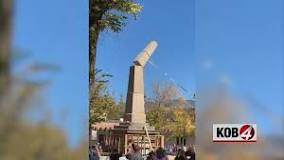Excoriation Nation
Let me blog a minute. . .
 Myra Ellen Jenkins would be happy she is not alive now. There is such a thing as living too long.
Myra Ellen Jenkins would be happy she is not alive now. There is such a thing as living too long.I wrote in the 1980’s about her involvement as New Mexico state historian in the first controversy over the historic obelisk in the center of the Santa Fe Plaza. It was all about a word. It was no deeper than a word. We are familiar with this simplicity these days.
The stone monument erected about a century and a half ago had four sides, each in memory of soldiers who had died in combat, but the main purpose was to memorialize Union soldiers who died in the war between the states. The offense was one sided, so to speak. It was on the side that was dedicated to those “who died in wars with savage Indians.”
The intolerable word “savage” was excoriated verbally in the late Sixties by various Friends of the Indigenous. Pueblo people so far as I know had nothing to do with the protest. The modifier “savage” implicitly distinguished them from the Plains Indians. That was the obvious function of the word. The intention was not to label all Indians as savages. Myra Ellen suggested resolving the dispute by posting an explanatory sign beside the obelisk. As a historian she wanted it to say that words evolve and monuments reflect the meanings of their times and that we should remember past times. (As Abraham Lincoln, whose statue was vandalized on Monday in Portland, said, “We cannot escape history.”)
The protesters back then, never precisely identified, had a less ambiguous solution. One afternoon a man in white overalls showed up looking official. He may have had officious assistants. He was armed with a hammer and chisel. He erased the word. So the monument stood for perhaps 50 years with a physical excoriation on the “Indians” side.
And on Monday the monument was destroyed by a crowd that was offended by history, or whatever. The only two who were immediately arrested, for conflict with police officers, were men in their twenties. News reports I read carelessly but logically identified the protesters as “activists” and implied they were Native Americans or something (one who was quoted in the New Mexican was identified as an indigenous person from Chihuahua.).
Editors would do a favor for the Pueblo people, among them jewelry sellers on the porch of the Palace of the Governors who have sat within site of the obelisk for probably a century, by clearly identifying the activists activating their ideas, or whatever.
The same editorial restraint ought to be kept in mind in posting stories about the seminal removal of Oñate’s foot at the memorial in Alcalde (Because Oñate tortured Acoma people that way). It was not done by Pueblo people. That, however, was a symbolic gesture with meaning, as opposed to a simple cancel of Myra Ellen’s principles.
LC

